

(Available on the first of each month to Tile Heritage members who e-mail the Foundation from the address they
would like
E-News sent to. Contact: foundation@tileheritage.org)
Dave Pinyerd of Historic Preservation Northwest sent us a fireplace from the organization’s headquarters in Albany,
Oregon. The tile was produced in 1930 by the Markoff Mosaic Tile Corp. of Inglewood, California. It’s Arch #37 in
the Markoff catalog. Although this fireplace is as rare as hen’s teeth, we suspect that many are out there that
people have simply misidentified as Batchelder or Claycraft. Click on www.hp-nw.com/fireplace.htm to see the
installation in detail.
The latest edition of Tile Heritage: A Review of American Tile History, vol. 7, no. 2, is fresh off the press. With
a focus on the evolution of tile use in the home, historian Susan Padwee presents “‘The House Sweet and Healthy’:
Tiles and Late-Nineteenth-Century Sanitation.” Enhanced with archival photos of three different Vanderbilt mansions
in New York, the article covers kitchens, laundries, bathrooms, fireplaces and floors. In addition, Michael Sims
offers “The Encaustic Tile in America Part Two: From Experiments to Infant Industry,” which describes the
painstaking efforts on the part of early tile makers to produce the illusive inlaid tile. Meet the entrepreneurs,
visit their modest factories, and witness the results of their diligence.
This stunning new book, arranged alphabetically by subject areas, captures the essence of the successful Flint
Faience Tile Company’s highly diversified production between 1921-33 in Flint, Michigan. The history of this
ceramic tile company, its major designers and the designs and styles of its products are woven throughout a
tapestry of more than 825 color photos illustrating both rare and popular tiles. Showcased are Art Deco and Arts
& Crafts style tiles, animal and nursery rhyme designs, geometric motifs, plants and flowers, dramatic murals,
and much more. Many sections feature photo documentation of these collectible tiles installed in homes, schools,
churches, restaurants, swimming pools, and more. Present day values are provided in the captions. This fascinating
and informative A to Z collector’s book is a valuable addition to the library resources of any tile and ceramics
collector or maker.
Margaret Carney is a ceramics historian, university professor, and museum curator. She applied for and received a
Doty Research Grant from the Tile Heritage Foundation to pursue this project, and she has presented the Foundation
with a 4” binder containing the results of her extensive research. Ken Galvas has been a collector of American art
pottery for nearly 30 years. He lives in the Flint area where he has amassed a notable collection of Flint Faience.
Flint Faience ranks among the finest tile producers in 20th century America, and this book proves it page after
page. It’s truly an inspiration!
A thriving terra cotta industry developed in central New Jersey, manufacturing terra cotta products that were
shipped around the world in the early twentieth century. The narrative and photographs illustrate the rise and
fall of the terra cotta industry in NJ, from the 1880s through the 1960s. Eight chapters include topics such as:
Architectural Ceramics; Color in Terra Cotta; Brick, Tile and Standardized Terra Cotta; The Manufacturing Process;
and Great Buildings of Terra Cotta. In addition, there is a Glossary of Terms and a Bibliography.
Supplies are limited. The Uncommon Clay publication is available without charge to the public, by written request
to the Middlesex County Cultural and Heritage Commission, 703 Jersey Avenue, New Brunswick, NJ 08901. Overseas
requests require a $10 check (USD) for shipping and handling, payable to County of Middlesex.
Congratulations are in order for Lesley Baker of Oakland, California, who won the Tile Heritage Prize at
“Feats of Clay XVII” at historic Gladding, McBean & Co. in Lincoln, California, April 24 – May 23, 2004. Baker’s
work titled “Impression of the Plan,” translucent porcelain with decals in wood frame, measures 24 H x 24 W x 2D.
From the statement of Richard Notkin, juror: “I gravitated towards sculptural pieces which reveal deep and/or
spiritual truths about our fragile existence in the universe, or which challenge that which we take for granted
by manipulating images or forms in a visually or intellectually provocative fashion. I chose work which reveals
the innermost concerns—the fears and desires—of its creator. I especially appreciate art which illuminates our
many human foibles and questions the social and political status quo, work that is occasionally a bit on edge or
downright angry.”
The Tile Heritage Prize is awarded to the tile artist whose tilework in the juror’s judgment best reflects the
ceramic traditions in America.
And how do we judge the success of the programs? We look at the people who participate. It’s their faces that tell
it all!

Normally, mid-summer on the Russian River, home for the Tile Heritage Foundation, is close to what most people
would consider paradise. Mornings are cool with overcast skies (we call it a “marine layer”). By noon the sun
has burned away the clouds, and the afternoons are warm, often hot. By the early evening a light breeze blows
up river bringing a slight chill to the air. Sunsets can be dramatic with the giant redwoods in silhouette
against the changeable sky.
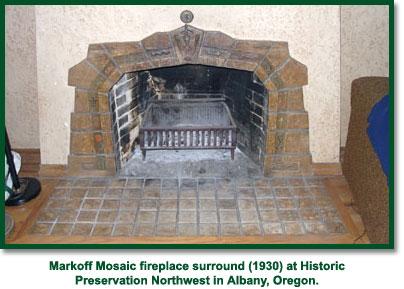
Recent Discovery

New Publications

Flint Faience Tiles A to Z by Margaret Carney and Ken Galvas.
• 11” x 8 1/2” • over 825 color photos • 272 pages with index and bibliography • $69.95
(CA residents add 7.5% sales tax) plus $6 for shipping/handling. Books are in stock!

Uncommon Clay, New Jersey’s Architectural Terra Cotta Industry was published by the Middlesex County Cultural
and Heritage Commission in spring 2004. It is a soft-cover, spiral bound edition of 60 pages with 41 full color
and b/w photographs and images. Project Advisors were: Susan Tunick, president Friends of Terra Cotta; Dr.
Richard Viet, assistant professor, Monmouth University; and Helen Henderson, historian and museum consultant.

Tile Heritage Prize

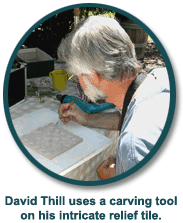
Keeping
The Craft
Alive!
The Tile Heritage workshop season is now in full swing. Following two successful programs in May,
“Magical Majolica at the Beach” with Irene de Watteville in Solana Beach, California, and “Mosaic Mélange for
the Outdoors” with Christie Rodgers in Austin, Texas, two others took place in June: “Constructing Relief on
Tile” with Kenyon Lewis in Cloverdale, California, and “Melding Clay Mosaic in the Tile Grid” with Joan Gardiner
in Middleburg, Virginia.
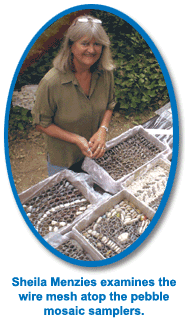
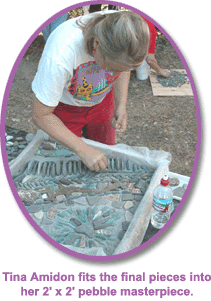
In July Diane Stacey hosted “From Altars to Fountains” at her studio in Encinitas, California, and Sheila Menzies
and Donna Billick teamed up to present “The Pleasures of Pebble Mosaic” on the rocky beaches of the Russian River
in northern California, the home of the Tile Heritage Foundation, where there was no shortage of material to work
with! In the shade of giant redwoods the group of ten participants spent three days engaged with both direct and
indirect setting methods, mesh mounting, mixing mortar and grout, and having a gay ol’ time. This was the first
workshop held at Tile Heritage and we look forward to doing it again next year.
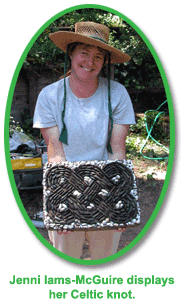
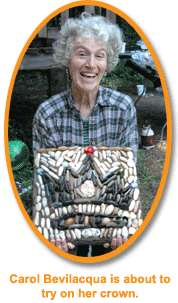
“Keeping The Craft Alive” is an exclusive educational workshop program presented annually by the Tile Heritage
Foundation in cooperation with a select group of studio artists from throughout the United States. These workshops
bring Tile Heritage together with the participating artists providing opportunities for people to have hands-on
experience with clay and other tile-related materials while at the same time raising funds in support of Tile
Heritage programs.